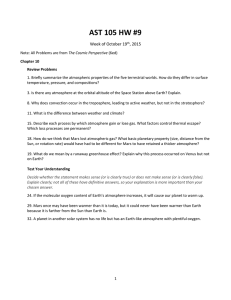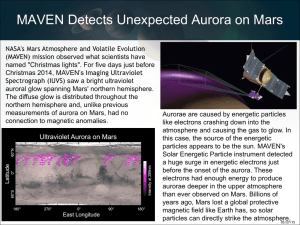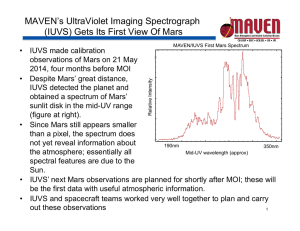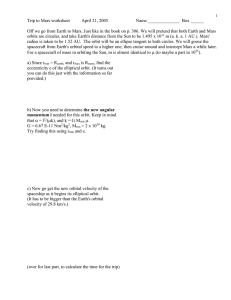Structure and composition of the neutral upper atmosphere
advertisement
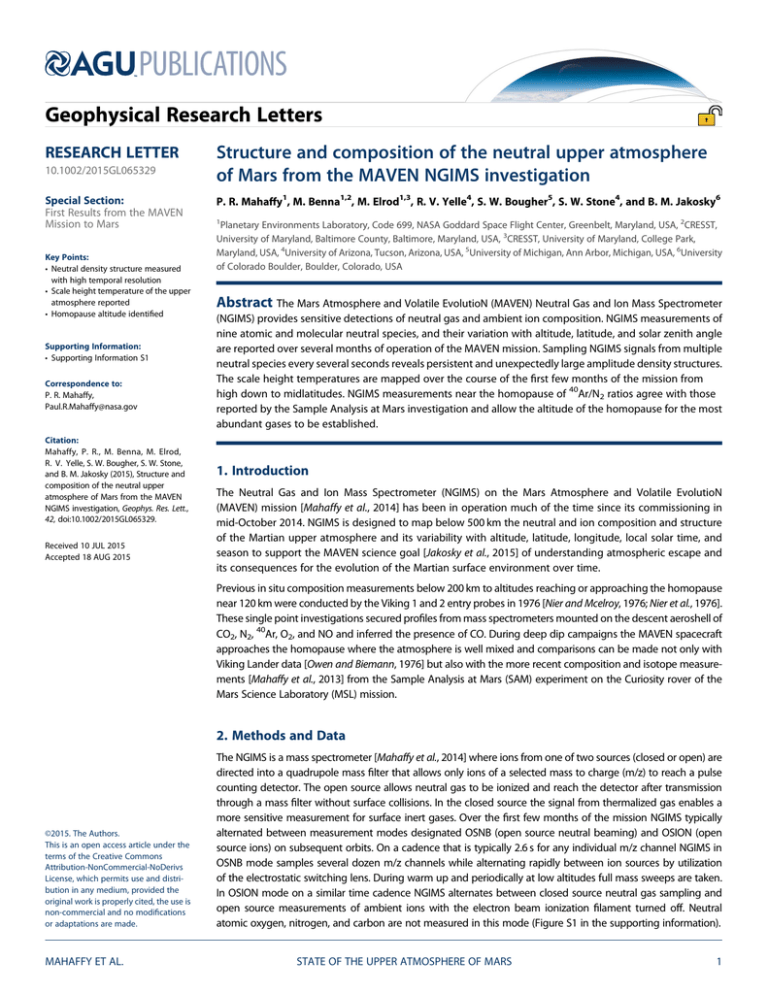
PUBLICATIONS Geophysical Research Letters RESEARCH LETTER 10.1002/2015GL065329 Special Section: First Results from the MAVEN Mission to Mars Key Points: • Neutral density structure measured with high temporal resolution • Scale height temperature of the upper atmosphere reported • Homopause altitude identified Supporting Information: • Supporting Information S1 Correspondence to: P. R. Mahaffy, Paul.R.Mahaffy@nasa.gov Citation: Mahaffy, P. R., M. Benna, M. Elrod, R. V. Yelle, S. W. Bougher, S. W. Stone, and B. M. Jakosky (2015), Structure and composition of the neutral upper atmosphere of Mars from the MAVEN NGIMS investigation, Geophys. Res. Lett., 42, doi:10.1002/2015GL065329. Received 10 JUL 2015 Accepted 18 AUG 2015 Structure and composition of the neutral upper atmosphere of Mars from the MAVEN NGIMS investigation P. R. Mahaffy1, M. Benna1,2, M. Elrod1,3, R. V. Yelle4, S. W. Bougher5, S. W. Stone4, and B. M. Jakosky6 1 Planetary Environments Laboratory, Code 699, NASA Goddard Space Flight Center, Greenbelt, Maryland, USA, 2CRESST, University of Maryland, Baltimore County, Baltimore, Maryland, USA, 3CRESST, University of Maryland, College Park, Maryland, USA, 4University of Arizona, Tucson, Arizona, USA, 5University of Michigan, Ann Arbor, Michigan, USA, 6University of Colorado Boulder, Boulder, Colorado, USA Abstract The Mars Atmosphere and Volatile EvolutioN (MAVEN) Neutral Gas and Ion Mass Spectrometer (NGIMS) provides sensitive detections of neutral gas and ambient ion composition. NGIMS measurements of nine atomic and molecular neutral species, and their variation with altitude, latitude, and solar zenith angle are reported over several months of operation of the MAVEN mission. Sampling NGIMS signals from multiple neutral species every several seconds reveals persistent and unexpectedly large amplitude density structures. The scale height temperatures are mapped over the course of the first few months of the mission from high down to midlatitudes. NGIMS measurements near the homopause of 40Ar/N2 ratios agree with those reported by the Sample Analysis at Mars investigation and allow the altitude of the homopause for the most abundant gases to be established. 1. Introduction The Neutral Gas and Ion Mass Spectrometer (NGIMS) on the Mars Atmosphere and Volatile EvolutioN (MAVEN) mission [Mahaffy et al., 2014] has been in operation much of the time since its commissioning in mid-October 2014. NGIMS is designed to map below 500 km the neutral and ion composition and structure of the Martian upper atmosphere and its variability with altitude, latitude, longitude, local solar time, and season to support the MAVEN science goal [Jakosky et al., 2015] of understanding atmospheric escape and its consequences for the evolution of the Martian surface environment over time. Previous in situ composition measurements below 200 km to altitudes reaching or approaching the homopause near 120 km were conducted by the Viking 1 and 2 entry probes in 1976 [Nier and Mcelroy, 1976; Nier et al., 1976]. These single point investigations secured profiles from mass spectrometers mounted on the descent aeroshell of CO2, N2, 40Ar, O2, and NO and inferred the presence of CO. During deep dip campaigns the MAVEN spacecraft approaches the homopause where the atmosphere is well mixed and comparisons can be made not only with Viking Lander data [Owen and Biemann, 1976] but also with the more recent composition and isotope measurements [Mahaffy et al., 2013] from the Sample Analysis at Mars (SAM) experiment on the Curiosity rover of the Mars Science Laboratory (MSL) mission. 2. Methods and Data ©2015. The Authors. This is an open access article under the terms of the Creative Commons Attribution-NonCommercial-NoDerivs License, which permits use and distribution in any medium, provided the original work is properly cited, the use is non-commercial and no modifications or adaptations are made. MAHAFFY ET AL. The NGIMS is a mass spectrometer [Mahaffy et al., 2014] where ions from one of two sources (closed or open) are directed into a quadrupole mass filter that allows only ions of a selected mass to charge (m/z) to reach a pulse counting detector. The open source allows neutral gas to be ionized and reach the detector after transmission through a mass filter without surface collisions. In the closed source the signal from thermalized gas enables a more sensitive measurement for surface inert gases. Over the first few months of the mission NGIMS typically alternated between measurement modes designated OSNB (open source neutral beaming) and OSION (open source ions) on subsequent orbits. On a cadence that is typically 2.6 s for any individual m/z channel NGIMS in OSNB mode samples several dozen m/z channels while alternating rapidly between ion sources by utilization of the electrostatic switching lens. During warm up and periodically at low altitudes full mass sweeps are taken. In OSION mode on a similar time cadence NGIMS alternates between closed source neutral gas sampling and open source measurements of ambient ions with the electron beam ionization filament turned off. Neutral atomic oxygen, nitrogen, and carbon are not measured in this mode (Figure S1 in the supporting information). STATE OF THE UPPER ATMOSPHERE OF MARS 1 Geophysical Research Letters 10.1002/2015GL065329 Figure 1. A mass spectrum taken at 180 km on orbit #1064 (Ls 256, LST 11:50 A.M., and latitude 4.5°S at periapsis on this orbit) in OSNB mode. Several singly and doubly charged ions produced in NGIMS by electron impact ionization from these neutral species are labeled. Example traces from the closed source are shown in Figure S1 in the supporting information. Shortly after NGIMS was exposed to the space environment by deployment of its pyrotechnically actuated breakoff cap, the instrument was configured to repeat OSION [Mahaffy et al., 2014] measurements on each orbit to search for signatures of comet Siding Spring whose coma encountered the atmosphere of Mars on 19 October 2014. NGIMS secured temporal variations from orbit to orbit in ions and the neutrals measured by the closed source. Eleven ions were observed [Benna et al., 2015] that were sourced from ablated dust from comet Siding Spring, and the decay time of these ions after the comet’s departure was measured. Data reported here includes all 202 OSNB orbits where the NGIMS open source axis was pointed 2° or less away from the velocity vector over the Martian solar longitude Ls period of 290–340. During this northern winter period (12 February to 19 May 2015) the solar activity as measured by the monthly averaged EUV F10.7 flux index Figure 2. An example of the variation with altitude of nine atomic and molecular species during a single deep dip pass on orbit #1064 (Ls 256, LST 11:50 A.M., and latitude 4.5°S at periapsis on this orbit) is shown. For the trace gas He, gas scattering in the instrument at the lowest altitudes may distort the profile. For those orbits where wave activity is not excessive the region between 200 and 300 km can generally be used to derive scale height temperatures as shown in Figure S2 in the supporting information. The orbit to orbit variability is illustrated in Figure S3. N, O2, O, and NO are derived from open source measurements and the remaining gases from closed source data. MAHAFFY ET AL. STATE OF THE UPPER ATMOSPHERE OF MARS 2 Geophysical Research Letters 10.1002/2015GL065329 Figure 3. Normalized density structure is illustrated for orbit #716 (Ls = 289, LST = 18:38, latitude = 44.4° at periapsis) early ° in February 2015 where periapsis was near the terminator, and the latitude of periapsis was 44.4 N. The middle and bottom show the variation in altitude and local solar time (LST) for this orbit. As the altitude changed by no more than 60 km the distance traversed along the spacecraft track was more than 1800 km. (123 at Earth) was approximately 75% of its peak value in this atypically weak solar cycle. Over this more than 14 week period two deep dip campaigns were conducted to altitudes below 130 km. The first of these in early February 2015 (Ls = 289–293) spanned latitudes of 40–45° with 36 orbits at periapsis and near the terminator, while the second in mid-April (Ls = 327–330) was near noon time near the equator. The MAVEN spacecraft’s orbital precession enabled latitude and local solar time variations at closest approach from 44.1°N to 25.2°S and from 6:35 P.M. back through noon and approaching 9:12 A.M. to be sampled. An example mass spectrum of ambient neutrals is shown in Figure 1 from the open source at an altitude of 180 km. The methods used to extend the dynamic range of the instrument by defocusing and to convert c/s to density are described in the supporting information and illustrated in Figure S1. Absolute errors for the major species (CO2, Ar, and N2) are estimated to be less than 20% and considerably lower for mixing ratios (Figure S4). 3. Upper Atmosphere Structure and Composition For midlatitude orbit #1064 during the second deep dip campaign whose inbound spectrum is shown in Figure 1, the minimum altitude was 133.8 km, the latitude of periapsis was 2.58°, and the local solar time at periapsis was noon. The variation in density for nine atomic or molecular species with altitude along the inbound portion of the orbital track is shown in Figure 2. The analysis of various isotopes and other species such as C and HxO products is ongoing and will be reported at a later time. Near the lowest altitudes there is very little vertical variation as the spacecraft approaches periapsis. The structure observed at these low altitudes reflects density waves that vary from orbit to orbit. The high temporal/spatial resolution sampling of the atmosphere achieved by NGIMS demonstrates this remarkably dynamic and variable environment MAHAFFY ET AL. STATE OF THE UPPER ATMOSPHERE OF MARS 3 Geophysical Research Letters 10.1002/2015GL065329 Figure 4. Variations of density for CO2, Ar, He, and O (Ls 288–326 and latitude at periapsis 46° to 4.3°) illustrates the gradual fall off of density at any altitude with solar zenith angle for (top left) CO2 and (top right) Ar, the enhancements and variation with altitude of (bottom left) He in the 30–60° SZA range, and the abundance at high altitudes of (bottom right) O. More observations will be required to see if the He enhancements at 34–65° SZA will persist as the number of measurements in each bin increases. The two deep dips are evident at low and high solar zenith angles. The space represented by the darkest blue was not sampled. with gravity waves propagating up from the lower atmosphere. For example, high variability is illustrated in Figure 3 for near-periapsis data for an orbit during the first deep dip where the MAVEN spacecraft was close to the terminator at periapsis latitude of 44.4°N. Gravity waves have been previously studied [Fritts et al., 2006] with density variations measured from accelerometers on the Mars Global Surveyor and Mars Odyssey spacecraft during their aerobraking campaigns. The density structures are highly variable, often show amplitude variations of tens of percent over the background levels and demonstrate variations with latitude and local solar time. Figure 4 maps the variation of the average density of CO2, Ar, O, and He with altitude and solar zenith angle (SZA) for the orbits selected for this study using bins of 5° SZA and 5 km altitude resolution. The SZA bins average in Ls, solar input, and other variations but enable a direct comparison with previous data from Viking and models. Vertical profiles at a SZA of 45° are shown in Figure 5 with sampling illustrated in Figure S2. The structure seen on individual orbits is averaged out in this data set. Sources of error are discussed in the supporting information. 4. Comparison With Surface Mixing Ratios Early measurements from MSL’s SAM experiment gave a ratio to CO2 of ~2% for 40Ar and N2 [Mahaffy et al., 2013]. Measurement over a Mars year from SAM showed the expected variation of the mixing ratio of these noncondensable gases with season. At the lowest altitudes sampled by NGIMS 40Ar and N2 ratios to CO2 approach the values reported from the SAM measurements on the surface (Figure 6). MAHAFFY ET AL. STATE OF THE UPPER ATMOSPHERE OF MARS 4 Geophysical Research Letters 10.1002/2015GL065329 Figure 5. Vertical profiles are illustrated for nine upper atmosphere species at 45° solar zenith angle. The averaging secured by binning the data from many orbits smooths out the gravity wave structure seen in individual orbits. The data are sampled from a subset of the Ls = 288–326 season and latitude at periapsis 46° to 4.3° with the number of averaged observations in each bin illustrated in Figure S2. This suggests that the homopause for these species is reached at approximately 130 km or slightly lower during these deep dips (Figure 6). 5. Upper Atmosphere Scale Height Temperatures As illustrated in Figure 2 at altitudes above ~200 km the atmosphere follows an approximately exponential decay of density with altitude and scale height temperatures derived from P(z) = Po exp( z/H) where H = (kT/Mg) with P(z) and Po being pressures at an altitude z and a reference altitude, k the Boltzmann constant, T the temperature in Kelvin, M the molecular mass, and g the acceleration due to gravity at the reference altitude can robustly 40 Figure 6. (left) Ar and N2 mixing ratios plotted versus total atmospheric density before, after, and during the second deep dip campaign (Ls = 326, latitude = 2° to 40 3 5°). Each point is the average density of either Ar or N2 at closest approach for that orbit. At the highest densities measured at about 10 kg/km the lowest altitudes reached are ~130 km. At these altitudes the mixing ratios approach the bulk atmospheric mixing ratios established by the SAM experiment on the Curiosity 40 rover. (right) The ratio of Ar and N2 to CO2 are shown for 5° binned solar zenith angles less than 20°. These orbits include the second deep dip campaign and adjacent orbits where the higher altitudes are covered. These comparisons with surface mixing ratios demonstrate that the homopause for these three gases should be reached under these conditions at ~130 km. MAHAFFY ET AL. STATE OF THE UPPER ATMOSPHERE OF MARS 5 Geophysical Research Letters 10.1002/2015GL065329 Figure 7. (top) Scale height temperatures derived from fits to NGIMS data between 200 and 300 km. Data are acquired in the Ls = 288–326 interval with latitude at periapsis 46° to 4.3°. (middle) The mean temperature in the 15–75° SZA region based on fitting inbound binned Ar, CO2, and O signals is 274 ± 6 K secured by averaging temperatures derived from these three independent determinations. The temperature drops by tens of Kelvin above 95° SZA. The apparent spike above SZA 85 may simply be a consequence of the limited sampling in these bins as illustrated in Figure S2. Temperature variation with (bottom) pressure for the two deep dip campaigns illustrate substantial differences at the lower altitudes and significant differences between the deep dip campaigns. The first deep dip (red) is centered around Ls = 289 at 46°N and the second (blue) around Ls = 326 near midlatitude. The Mars/Sun distance for these two deep dips was 1.41 and 1.48 AU, respectively. MAHAFFY ET AL. STATE OF THE UPPER ATMOSPHERE OF MARS 6 Geophysical Research Letters 10.1002/2015GL065329 be secured in several gases assuming each species has its own scale height. Although the gravity wave structure puts a great deal of scatter in individual temperatures, average temperatures can be derived using many orbits. Figure 7 shows inbound temperatures derived from each of these orbits plotted against the solar zenith angle at the midpoint of the altitude used, average (binned) temperatures, and temperature variations at lower altitudes during the two deep dip campaigns. 6. Discussion The upper atmosphere of Mars studied here in the 130–300 km region of the thermosphere and lower exosphere provides the source of gas that can escape to space. A detailed understanding of both its average state mapped over the planet as a function of season (the focus of this manuscript) and the variability with external drivers is necessary to provide input for models of escape and long-term change. At this early stage of the MAVEN mission a significant data set revealing the average state of the neutral upper atmosphere over a portion of Mars year has been mapped and greatly extended the data sets from previous and ongoing missions. Detailed comparisons of the NGIMS neutral structure and composition measurements with both data from surface measurements, with other instruments on MAVEN, and with the state-of-the-art upper atmosphere models such as the Mars Global Ionosphere-Thermosphere Model [Bougher et al., 2015] are ongoing. Atmospheric measurements from the Martian surface with the SAM experiment on Curiosity provide ground truth for the search using NGIMS data for the location of the homopause during deep dips. Acknowledgments The dedicated NGIMS operations and software team is acknowledged including Eric Raaen, Micah Johnson, Ed Weidner, Eric Lyness, Tiffany Naves, Tom Nolan, Kiran Patel, and Nick Dobson. The NGIMS data are available in a readily accessible format on the Planetary Data System. This investigation was supported by the MAVEN project and by NASA’s Science Mission Directorate. The Editor thanks Francois Forget and an anonymous reviewer for their assistance in evaluating this paper. MAHAFFY ET AL. References Benna, M., P. R. Mahaffy, J. M. Grebowsky, J. M. C. Plane, R. V. Yelle, and B. M. Jakosky (2015), Metallic ions in the upper atmosphere of Mars from the passage of comet C/2013 A1 (Siding Spring), Geophys. Res. Lett., 42, 4670–4675, doi:10.1002/2015GL064159. Bougher, S. W., D. Pawlowski, J. M. Bell, S. Nelli, T. McDunn, J. R. Murphy, M. Chizek, and A. Ridley (2015), Mars Global Ionosphere-Thermosphere Model: Solar cycle, seasonal, and diurnal variations of the Mars upper atmosphere, J. Geophys. Res. Planets, 120, 311–342, doi:10.1002/ 2014JE004715. Fritts, D. C., L. Wang, and R. H. Tolson (2006), Mean and gravity wave structures and variability in the Mars upper atmosphere inferred from Mars Global Surveyor and Mars Odyssey aerobraking densities, J. Geophys. Res., 111, A12304, doi:10.1029/2006JA011897. Jakosky, B. M., et al. (2015), The Mars Atmosphere and Volatile Evolution (MAVEN) Mission, Space Sci. Rev., doi:10.1007/s11214-015-0139-x. Mahaffy, P. R., et al. (2013), Abundance and isotopic composition of gases in the Martian atmosphere from the Curiosity rover, Science, 341(6143), 263–266. Mahaffy, P. R., et al. (2014), The neutral gas and ion mass spectrometer on the Mars Atmosphere and Volatile Evolution Mission, Space Sci. Rev., 185, doi:10.1007/s11214-11014-10091-11211. Nier, A. O., and M. B. Mcelroy (1976), Structure of neutral upper-atmosphere of Mars—Results from Viking 1 and Viking 2, Science, 194(4271), 1298–1300. Nier, A. O., W. B. Hanson, A. Seiff, M. B. Mcelroy, N. W. Spencer, R. J. Duckett, T. C. D. Knight, and W. S. Cook (1976), Composition and structure of Martian atmosphere—Preliminary results from Viking 1, Science, 193(4255), 786–788. Owen, T., and K. Biemann (1976), Composition of atmosphere at surface of Mars—Detection of Argon-36 and preliminary analysis, Science, 193(4255), 801–803. STATE OF THE UPPER ATMOSPHERE OF MARS 7

